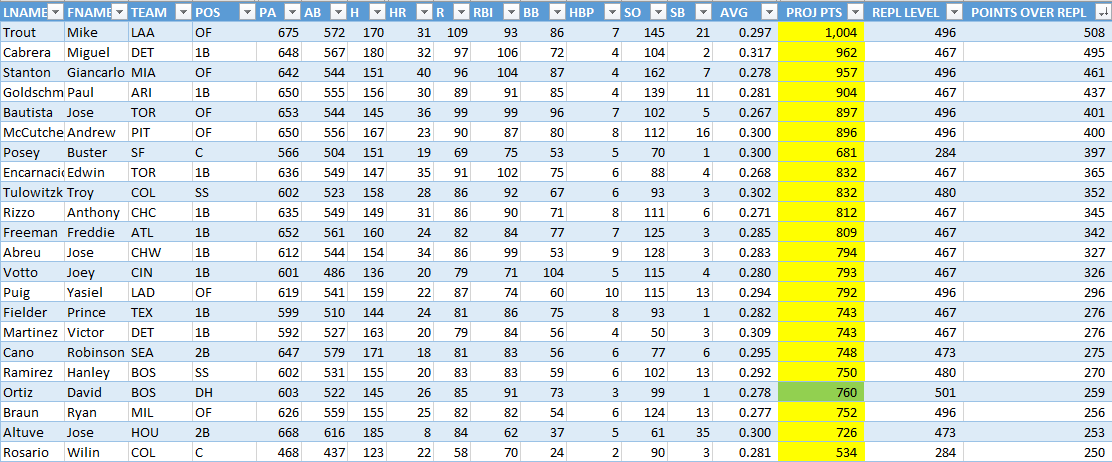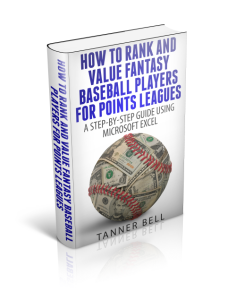Welcome to a step-by-step guide to help you create your own projection-based points league rankings using Microsoft Excel.
Why I Created This
Twitter is a great medium for getting news and finding interesting reading material. But it sucks as a channel for disseminating fantasy baseball advice. Yet that’s exactly what I see.
@FantasyAnalyst: Points league – Chris Davis or Brian McCann?
Are you kidding me!?!?!?! That makes me cringe. What are the league settings? How many points for a strikeout? A Home Run? How many teams are in the league? How many catchers on a team?
There is no way to properly ask that question in 140 characters and there’s no responsible way of answering that question either.
This leads me to my point.
The only way to get proper and accurate rankings for your points league is to construct the rankings yourself.
That’s why I created this series. It will take you step-by-step through the process of creating rankings customized specifically for your own league.
About This Series
You can find a link to each of the first six parts in the series below. At the end of each part is a sample Excel file you can download and refer to, use to verify your formulas, etc.
Familiarity with Excel is recommended, but you don’t need advanced skills to start. I will teach you what you need to know.
Let’s Get Started
- Part 1 – Download Projection Data and Player ID Map
- Part 2 – Set Up League Scoring Settings
- Part 3 – VLOOKUP, Excel Tables, and Structured References (Hitter Rankings)
- Part 4 – Pitcher Rankings
- Part 5 – Calculating Projected Points
- Part 6 – Replacement Level and Position Scarcity
Important Note For Excel For Mac Users
If you are using a Mac, you will need at least Excel 2011 or greater and some of the screenshots I include will be different than what you will see on the Mac version of the program. If you are using a version from prior to 2011 there is a good chance that some of the formulas used in the series will not work.
I apologize for this, I wish Microsoft could somehow keep the Windows and Mac versions of Excel the same.
Want to Know How to Convert These Rankings Into Dollar Values?
If you participate in an auction league, especially one with keepers, please click here to read all about how to convert the points above replacement level for each player into a dollar value.
“How to Rank and Value Fantasy Baseball Players for Points Leagues” is a 150+ page guide that I believe is the best step-by-step guide you can find on creating your own custom rankings and dollar values for your points league.

Found it! LOL
Hey Tanner, ran into a small problem with translating the Points Above Replacement to player values: it’s a head-to-head points league where the scoring is way slanted toward pitching.
Chris Sale is worth 315.5 points above replacement level as the top pitcher, while Mike Trout is 210 points above replacement as the top hitter. When I use the standard 65/35 split on hitters/pitchers, Sale’s worth $41 and Trout is worth $67.
Intuitively it makes sense that Trout is the top player on the board, but given how many more points pitchers score (1 for K, 3 for IP, 5 for Win and Save, 4 for QS, -5 for L, -1 for ER, BB, and H allowed) compared to hitters (1 for Total Base, BB, Run, RBI, SB, -1 for Ks), would making it closer to a 50/50 split make sense to you? First time playing head-to-head points league, so I’m not sure how much sense the values as currently constructed make. Thanks!
Hi Alex. I never followed through on some of the things discussed in the article, but I wrote a little about if we need a 65/35 split in a points league. You can read those thoughts here.
I’d probably take a look at how many points above replacement come from all your draftable pitchers and then calculate the points above replacement for all the draftable hitters. Then think about what that means.
For example, you might find that 70% of all points over replacement come from pitchers. That means 30% comes from hitters. But to then apply a split that makes those 30% of points from hitters actually get 65% of the money allocated to them seems incorrect.
I’m thinking I would not apply any split at all, unless you had a good reason to. At the end of the day, a point from a pitcher is worth the same as a point form a hitter. Hope that helps some.
I agree with your logic, I think I’m going to take out the split and have them on equal footing. Thanks for the timely and detailed response, this was extremely helpful